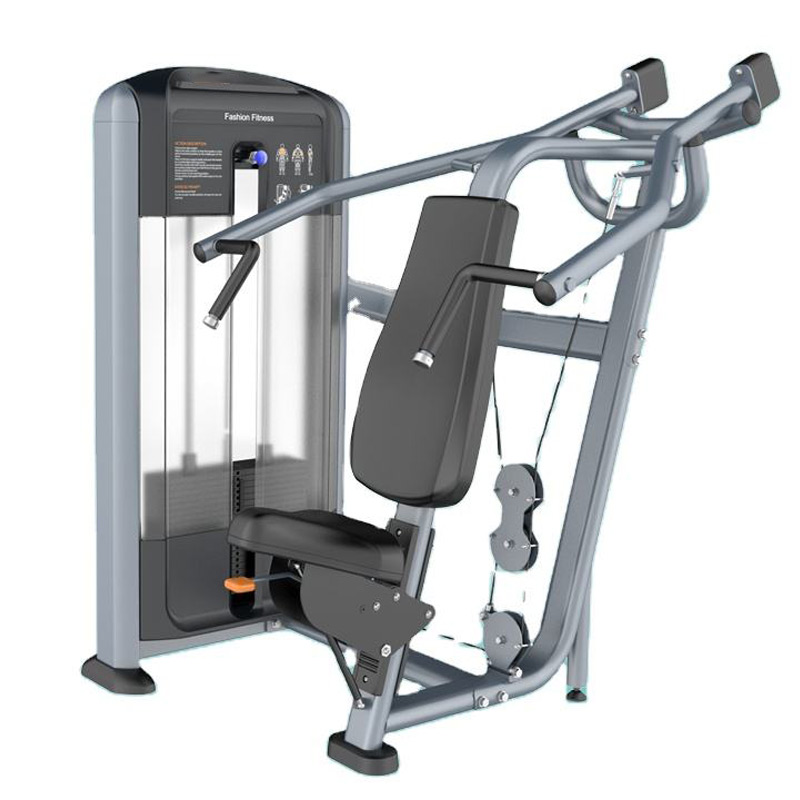The split shoulder selection trainer, often known as a shoulder isolation machine or a shoulder selectorized machine, is a specialized piece of gym equipment designed to target the shoulder muscles through various movements. It typically focuses on isolating and strengthening the deltoids (front, side, and rear) and other related shoulder muscles. Here’s an introduction to the split shoulder selection trainer:
Design and Features
- Structure: The machine generally features a seat with a backrest and adjustable arms or handles that allow for various shoulder exercises. It often has separate weight stacks or resistance settings for different movements.
- Adjustable Arms or Handles: The machine includes arms or handles that can be adjusted to different heights and angles to accommodate different exercises and user heights.
- Weight Stack: Resistance is provided by a weight stack that can be adjusted using a pin to set the desired weight. Some models may use a plate-loading system.
- Multiple Functions: The machine may have different settings or configurations for performing exercises like shoulder presses, lateral raises, and rear delt flyes.
Benefits
- Muscle Isolation: The machine allows for targeted isolation of the shoulder muscles, helping to build strength and definition in the deltoids and surrounding areas.
- Controlled Movement: It provides a controlled range of motion, which helps maintain proper form and reduces the risk of injury.
- Versatility: The machine can typically perform multiple shoulder exercises, making it a versatile addition to any strength training routine.
How to Use the Split Shoulder Selection Trainer
Shoulder Press
- Target Muscles: Anterior deltoids, triceps, upper chest
- Setup: Adjust the seat and handles so that the handles are at shoulder height.
- How to Perform:
- Position Yourself: Sit with your back straight and feet flat on the floor. Grip the handles with an overhand grip.
- Press Up: Engage your shoulder muscles and press the handles upward until your arms are almost fully extended.
- Control the Descent: Slowly lower the handles back to the starting position, maintaining tension in your shoulders.
Lateral Raise
- Target Muscles: Lateral deltoids, upper traps
- Setup: Adjust the arms to the lateral raise position, usually at shoulder height.
- How to Perform:
- Position Yourself: Sit with your back straight and grip the handles with your arms slightly bent at your sides.
- Raise: Lift the handles outward and upward to shoulder height, keeping your elbows slightly bent.
- Control the Descent: Lower the handles back to the starting position with control.
Rear Delt Fly
- Target Muscles: Posterior deltoids, upper back
- Setup: Adjust the arms so that they are in front of you, or use the machine in a rear delt fly configuration.
- How to Perform:
- Position Yourself: Sit with your back straight and grip the handles with a neutral grip.
- Fly: Pull the handles outward and backward, squeezing your shoulder blades together.
- Control the Descent: Return the handles to the starting position slowly, maintaining tension in your rear deltoids.
Tips for Effective Use
- Warm-Up: Warm up your shoulder muscles with dynamic stretches or light exercises before starting.
- Breathing: Exhale during the exertion phase of the exercise (e.g., pressing up or raising) and inhale as you return to the starting position.
- Form: Focus on maintaining proper form throughout the exercise. Avoid using excessive weight that could compromise your technique.





















































Reviews
There are no reviews yet.